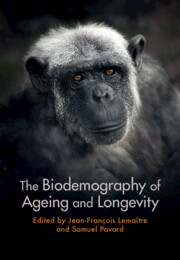Book contents
- The Biodemography of Ageing and Longevity
- The Biodemography of Ageing and Longevity
- Copyright page
- Dedication
- Contents
- Contributors
- Foreword
- Acknowledgements
- 1 The Eternal Youth of Ageing Research
- 2 Theories of Ageing across Ages
- 3 The Diversity of Longevity Metrics
- 4 The Meaning of ‘Exceptional Longevity’
- 5 The Inevitability of Senescence
- 6 The Untapped Potential of Zoo and Aquarium Data for the Comparative Biology of Ageing
- 7 Perspectives in Comparative Biology of Ageing
- 8 An Integrative Approach to Understanding Variation in the Form, Pattern and Pace of Ageing
- 9 Sex Differences in Lifespan, Ageing and Health in the Living World
- 10 Evolution of Human Reproduction, Ageing and Longevity
- 11 Lifespan and Mortality in Hunter-Gatherer and Other Subsistence Populations
- 12 Longevity in Modern Populations
- 13 Health Transition and Population Ageing
- 14 Limit of Human Longevity
- 15 Mortality Modelling at the Oldest Ages in Human Populations
- 16 Lessons from Exceptionally Long-Lived Individuals and Long-Living Families
- 17 Human Populations with Extreme Longevities
- 18 Socio-Economic Consequences of Increased Longevity in Contemporary Populations
- Index
- References
14 - Limit of Human Longevity
Historical Perspectives and a New Metric
Published online by Cambridge University Press: 14 November 2024
- The Biodemography of Ageing and Longevity
- The Biodemography of Ageing and Longevity
- Copyright page
- Dedication
- Contents
- Contributors
- Foreword
- Acknowledgements
- 1 The Eternal Youth of Ageing Research
- 2 Theories of Ageing across Ages
- 3 The Diversity of Longevity Metrics
- 4 The Meaning of ‘Exceptional Longevity’
- 5 The Inevitability of Senescence
- 6 The Untapped Potential of Zoo and Aquarium Data for the Comparative Biology of Ageing
- 7 Perspectives in Comparative Biology of Ageing
- 8 An Integrative Approach to Understanding Variation in the Form, Pattern and Pace of Ageing
- 9 Sex Differences in Lifespan, Ageing and Health in the Living World
- 10 Evolution of Human Reproduction, Ageing and Longevity
- 11 Lifespan and Mortality in Hunter-Gatherer and Other Subsistence Populations
- 12 Longevity in Modern Populations
- 13 Health Transition and Population Ageing
- 14 Limit of Human Longevity
- 15 Mortality Modelling at the Oldest Ages in Human Populations
- 16 Lessons from Exceptionally Long-Lived Individuals and Long-Living Families
- 17 Human Populations with Extreme Longevities
- 18 Socio-Economic Consequences of Increased Longevity in Contemporary Populations
- Index
- References
Summary
As far back as the seventh century BC, the Nineveh tablets and earliest surviving Greek poems bore witness to the human preoccupation with immortality, eternal youth and the comparative longevity of species. While the origins of these discussions can be traced back to ancient thinkers like Aristotle and Plutarch, it was not until the Renaissance of the sixteenth century that these ideas experienced a notable revival in the West. The seventeenth-century founders of modern science were distinguished from alchemists not so much by their objectives, such as living for a thousand years, but by the methods they either used or proposed to achieve their desired results. Despite the Enlightenment giving rise to scientific upheavals that began to challenge the status quo, theories were tested with only few empirical data until the beginning of the twentieth century. Today, the click of a button will provide quality data on human longevity covering many years in at least 41 countries, thanks for to the Human Mortality Database (HMD). After first presenting an overview of the historical perspective, this chapter explores trends of a recently introduced longevity indicator from the early twentieth century. It highlights the benefits of this metric in comparison to traditional measures and employs a decomposition approach to quantify the role of old-age mortality changes in shaping recent trends in human longevity.
Keywords
- Type
- Chapter
- Information
- The Biodemography of Ageing and Longevity , pp. 275 - 299Publisher: Cambridge University PressPrint publication year: 2024

